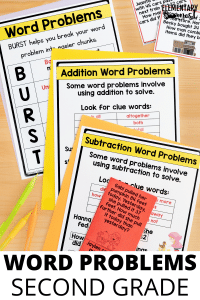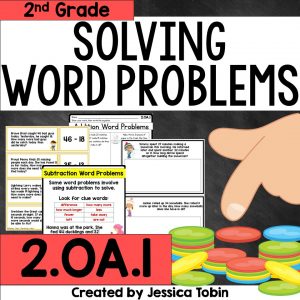
This blog post is all about teaching 1st and 2nd grade students a variety of word problem strategies. Starting in 1st grade, students will begin solving word problems in these Common Core math domains: Operations and Algebraic Thinking, Number and Operations in Base Ten, Geometry, and Measurement and Data. By 2nd grade, students are building on their prior knowledge and applying even more word problem strategies for solving problems in these domains. It is important to teach students a variety of strategies in order for them to find the best fit for their learning style.
Different Types of Word Problems
There are many different types of word problems used in mathematics. Students need to be proficient in the different styles of word problems. Additionally, it is key that they know which word problem strategies are appropriate for each style of problem. Today, we will discuss strategies for joining, separating, part-part-whole, missing part, comparison, and multi-step word problems.
Joining word problems- These problems involve 3 numbers, the initial amount, the change amount, and the resulting amount. Students are adding and bringing amounts together.
Separating word problems-These problems are similar to joining, but ask the students to separate or subtract the amounts.
Part-part-whole word problems- Part-part-whole word problems involve only 2 numbers that come together to make up a whole.
Missing part word problems- In this style of problem, students are solving to find the missing part in a part-part-whole problem.
Comparison word problems- Comparison problems involve finding the difference between 2 values. They tend to use words such as “more” and “fewer.”
Multi-step word problems- This problem style involves more than one operation. Students may use a combination of addition and subtraction in 1st and 2nd grade multi-step word problems. Starting in 3rd grade, students will also incorporate multiplication and division.
Create a Mnemonic Device

When teaching word problem strategies to students, it is a great idea to begin with a mnemonic device anchor chart such as this one. This BURST chart will serve as a very important visual aide in your classroom. It will help your students remember the important details and steps in solving word problems. It will also help them eliminate information in the word problem that is not needed to solve the problem.
The BURST strategy stands for:
- Box the important numbers and math information
- Underline the question or action statement
- Restate the question
- Show your work
- Tell your answer and describe your reasoning

Start with Modeling
Modeling how to use the BURST word problem strategy with a variety of word problem styles is essential. This step-by-step process will help your students think critically through the problems using this strategy. Modeling during whole-group instruction and small groups will help you serve all of your students at their level. By asking guided questions, students will learn how to pick out the important information, the question, and solve for the answer. Modeling how to use the BURST word problem strategy with each style of word problem is key.
Offer Different Ways to Solve
While there are many strategies for solving word problems, it is important to help students find the strategy or strategies that work best for their learning style. Some students will benefit from drawing a picture while others prefer to use an equation. Kinesthetic learners may choose to solve using manipulatives to act out the problem. Allowing students to use the strategy that works best for them is key.
When to Incorporate Word Problems
During a math unit, teachers should incorporate word problems towards the end of the unit. This will ensure that the standard and skill have been taught explicitly first. Students need time to practice the skill before applying it to more complex word problems. As a teacher, use your best judgment to determine when your students are ready for word problems. Some students may be ready before others, which is where small group time is beneficial. This allows for reteaching, extra practice, and enrichment.
Need to Teach Word Problems Virtually?

If you are needing an effective, fun way for your students to practice word problems digitally, especially during distance learning, these math word problem resources are for you! These can be completed via Google Slides and shared via Google Classroom.
Need to draw Part A to show your work and solve your problem?
- Click the drop down arrow next to the “line tool” in Google Slides. Scroll down and select the “scribble tool” to draw.
- Students can also solve their math word problems in Google Draw and then upload to Google Classroom or insert that drawing into Part A of their Google Slides problem.
- Another option is for students to solve the problem either on paper or with manipulatives and then snap a picture of their work and insert it into their Slide.
FREE 2nd Grade Math Lesson PlaN from 2.NBT.2!

FREE 2nd Grade Math Lesson Plan Sample from 2.NBT.2!
Get this 2.NBT.2 Lesson Plan freebie will be sent directly to your inbox.
Resources to Help Practice Word Problems
These 1st and 2nd grade word problem resource bundles are available in both paper and digital versions. They come complete with BURST word problem strategy posters and bookmarks, answer keys, rubrics, and a variety of short answer word problems.
- 1st Grade Common Core Aligned Math Word Problems Bundle
- 2nd Grade Common Core Aligned Math Word Problems Bundle
I also have a 2nd grade unit that comes with ready-made lessons and math group activities. The products above are supplemental word problem activities to practice all the Common Core standards. The unit below is a unit on HOW to teach word problems. It aligns to one specific math standard.



Click the buttons for the link you need.
Thank you so much for reading! I hope you walk away with new ideas on teaching word problems and how to incorporate them into your math lessons.

Looking for other math blog posts to read about?




















